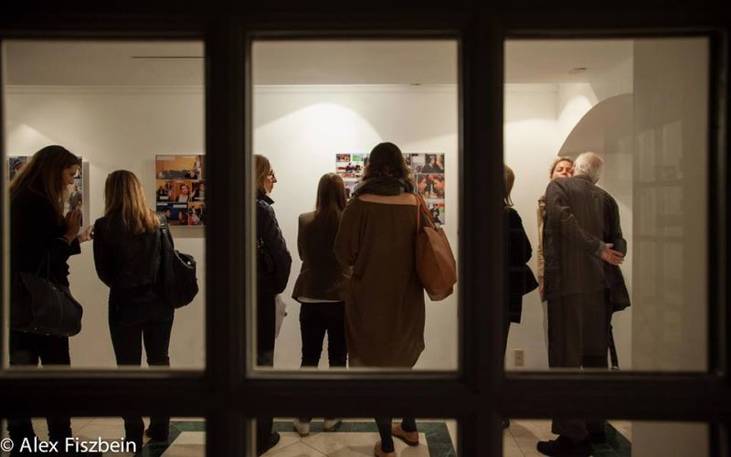


Ileana Florescu [2] was born in Asmara (Eritrea) of an Italian mother and an English father, who was of Romanian origin. After having spent her childhood in Morocco, France, England and Switzerland, she settled in Italy and earned a master degree in Humanities. Despite a natural talent for painting and drawing, she entered the academic world taking part in Prof. Sergio Bertelli [3]’s History Workshop, and specializing her studies on the Commedia dell’Arte and the rituals of Italian Renaissance [4] courts.
In 2001 her work “Meteorite I” was exhibited for the first time by the Pio Monti Contemporary Art Gallery [5] in the group show “Tra Cielo e Terra.” Her first solo exhibition, “Scie,” was in 2002, curated by Diego Mormorio [6] at the Roman Gallery Acta International [7]. In the same year, she decided to relocate her studio to the former pasta factory Cerere, historic seat of the School of San Lorenzo.
As the years went by one show followed another and that path took her to NYC at Casa Italiana Zerilli-Marimo. NYU's Italian culture house is hosting Florescu's exhibition Io E Calliope (Calliope and I), after its acclaimed debut at the Casa delle Letterature in Rome (2012).
The exhibition consists of twelve works, each a double page of approximately twelve photographs with word balloons (some in Italian, others in English). Each work represents a fotoromanzo (literally a photo-novel) a popular magazine format born in Italy in the 1940's.
Commonly a fotoromanzo was featured in a magazine yet it looked like a comic book, with photos instead of illustrations, combined with small dialogue bubbles. Typically the stories were simple and enveloped in a dramatic plot that aimed to teach a lesson at the end. Soon after their inception, fotoromanzi became popular outside of Italy, in countries like Spain, France and Latin America (where they endure to this day). “The genre, soap operatic cliches and torrid romances interpreted originally by improvised actors (including Sofia Loren at the beginning of her career) is practically unknown to American audiences.”
“Fotoromanzi are like spaghetti, a totally Italian phenomenon,” Ileana Florescu has said, “ It's an excellent grid, because it forces you to be concise. I could fill out only two pages, and it was not easy. We also had to work on the graphics, not just on beautiful images and on dialogue.”
With Io e Calliope, Florescu transforms the visual and literary language of the fotoromanzo, giving the format a whole new aesthetic and register of meaning. “She described the project to me,” Russell Banks, invited to speak the night of the opening said, “and I said oh this is what I really believe, that high art begins in low art. And low art is what produces high art if you raise it up. It's not the other way around.”
The photographer has carefully selected scenes and text from classical literature that have resonated personally for her throughout her life – from Cervantes' Don Quixote [8], to Orwell's Animal Farm, and Saint-Exupery's The Little Prince. She used family members and friends as actors, scouted locations, gathered the furniture, costumes and props to achieve a complex and subtle work where every detail is significant, from the choice of her players to the seemingly trivial. “Everything is HOME-MADE,” she joked, “I did it all! And I got friends, my children (appearing in Truth Does not Tolerate Love taken from The Man Without Qualities by Musil), writers... all sorts of people involved in the project. In the scene from The Little Prince, by brother plays Saint-Exupery while my nephew plays the Little Prince. ”
It's a complex work that the artist has taken seriously. “I learned the technique thanks to a photographer who shot fotoromanzi for years, Fabrizio Albertini [9]. Choosing the scenes to capture was quite hard. The novels were easy to select, but the actual scene and the dialogue was a totally different thing. The dialogue had to represent a summary of the novel but it also had to communicate something about me and about the characters. I wanted to hug literature.”
Florescu continued to explain that Don Quixote was one of the most fun story to shoot as it directly spoke to her. “Choosing the text was hard but I found a part that describes the differences between writing poetically and writing historically. This touched me because I wrote a book about historical mistakes in cinema.” She shot a scene from Bulgakov's The Master and Margarita with Russell Banks, who wanted to be in something by Hemingway but the photographer is not a big fan so she convinced him otherwise.
Two fotoromanzi in the exhibition are quite different: one because there are no humans (from Thoreau's Walden) and one because it only features animals (from Orwell's Animal Farm). “I never though I could have a horse act a scene with a pig,” Florescu said, but she accomplished it pretty well. Animal Farm is one of the first pieces that can be admired upon entering Casa Italiana. Two pieces are at the entrance while the rest are in the gallery and can be admired one by one as part of a flowing story within different stories.
The show is on view until October 28th.
Source URL: http://test.casaitaliananyu.org/magazine/events/reports/article/art-fotoromanzo-view-casa-italiana-zerilli-marimo
Links
[1] http://test.casaitaliananyu.org/files/ioecalliope1413695446jpg
[2] http://www.ileanaflorescu.com/ileana-florescu/
[3] http://it.wikipedia.org/wiki/Sergio_Bertelli
[4] http://en.wikipedia.org/wiki/Italian_Renaissance
[5] http://piomonti.com/
[6] http://www.lafeltrinelli.it/libri/diego-mormorio/171543
[7] http://www.ilpontecontemporanea.com/wp/portfolio/florescu-ileana/
[8] http://en.wikipedia.org/wiki/Don_Quixote
[9] http://www.fabrizioalbertini.com/